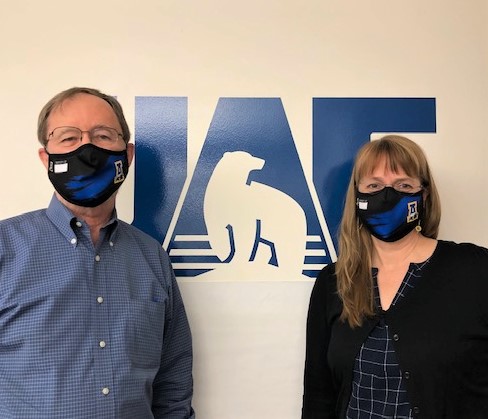Friday Focus: Optimism reigns at HAARP
April 22, 2021
— by Nettie La Belle-Hamer, interim vice chancellor for research
One of the most valuable attributes of a successful researcher, in addition to intelligence
and drive, is optimism. To be fair, intelligence is a given, and advanced degrees
come due to intelligence and the drive that often comes with it. But, success depends
on passion, tenacity and a strong belief in science. Together, that looks like optimism
to me. A great example of this made the news recently, celebrating a new grant award that came to UAF after many years of hard work. Here is the story behind the story
through the lens of optimism.

The High-frequency Active Auroral Research Program facility, or HAARP, was constructed by the U.S. Department of Defense in 1990. It was then, and has remained, the most capable and powerful high-frequency transmitter in the world. The DoD operated HAARP for decades, seeking answers to specific research questions relevant to the DoD relating to the Earth’s magnetic field. When those investigations were completed by the U.S. Air Force, the expensive stewardship of the facility was no longer of value to the DoD. The dismantling of the instrument began. The bulldozers were ready. Without UAF stepping up to accept stewardship for HAARP, this almost-$300 million, one-of-a-kind research instrument would have been destroyed. Once gone, it would be gone forever.
In a series of conversations with the U.S. Air Force, including then UA President Pat Gamble and Geophysical Institute Director Bob McCoy, UAF agreed to take on the seemingly impossible task of owning and operating this partially decommissioned, expensive to operate, but scientifically important facility in 2015. Director McCoy’s purpose was to widen access to enable the civilian research community to benefit from its exceptional capabilities. He felt then, and still does today, that the usefulness of this instrument has not yet been fully realized.
He and his small band of scientists and engineers who worked together to save HAARP are passionate about space physics. Specifically, they are focused on investigating how the sun affects the Earth’s ionosphere and magnetosphere and the real-world applications of this science. This passion drove them to continue to fight for the life of the 180 antennas able to send radio waves into the ionosphere to observe the interactions. There are other ways to study the ionosphere, such as by launching rockets into it or flying satellites through it.
“But with HAARP, we kind of reach out and touch it with radio waves,” McCoy said.
McCoy’s new grant success comes after six years of tenaciously pursuing the funds to support the newly created Subauroral Geophysical Observatory for Space Physics and Radio Science that is housed at the existing HAARP site in Gakona. This observatory, rebuilt to operational capabilities under the leadership of UAF HAARP manager Jessica Matthews, will not require any new construction. Due to its crown jewel, HAARP, this new funding represents new research taking place at the existing facility. The university does hope to add additional instruments to the HAARP site over time, but for now the tenacity of this team has created opportunities for science and technology advancement at UAF.
As has been the case with other Class-1 geospace facilities, the powerful capabilities of this ionospheric heater are expected to power groundbreaking new discoveries for potentially decades to come. The purpose of this work is to enhance the United States’ civilian research infrastructure by supporting the first wave of these investigations within the open NSF research community. It will create a critical mass of investigators and ideas that will seed future applications and new research focus areas. Simply stated, the work now funded by NSF will be the bridge that allows the United States to fully realize the potential of this existing research asset. Things are looking very optimistic indeed for HAARP!
HAARP, like so many other research stories at UAF, gives me the optimism to keep going. Passion, tenacity and a strong underlying belief in the inherent value of science — these are the things that will get UAF through the tough times. With optimism, we can work together to achieve success. Please share with me your research success stories and let our collective success inspire our students, community, and ultimately, our future together.
Friday Focus is a column written by a different member of UAF’s leadership team every week. On occasion, a guest writer is invited to contribute a column.


